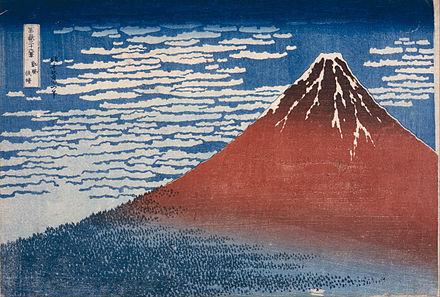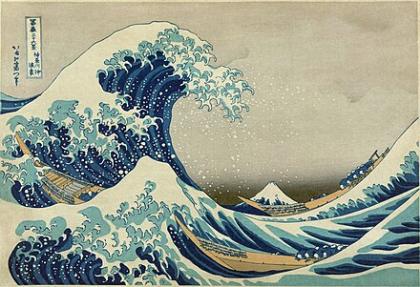Katsushika Hokusai, an iconic figure in Japanese art, is best known for his woodblock print series “Thirty-Six Views of Mount Fuji.” His works capture the beauty of nature and the dynamic forces within it, leaving an indelible mark on the art world.
Early Life and Training
- Born: 1760 in Edo (modern Tokyo)
- Original Name: Tokitarō
- Training: Apprenticed to Katsukawa Shunshō, a leading ukiyo-eUkiyo-e, meaning "pictures of the floating world," is a genre of Japanese art that flourished from the 17th to the 19th century. These woodblock prints and paintings capture the vibrant urban culture of Edo-period Japan, depicting everything from beautiful women to dramatic landscapes. Origins and Development • Period: Emerged during the Edo period (1603-1868) • City of Origin: Edo (modern More artist
Hokusai’s early life set the stage for a prolific career. His apprenticeship under Shunshō introduced him to the world of ukiyo-eUkiyo-e, meaning "pictures of the floating world," is a genre of Japanese art that flourished from the 17th to the 19th century. These woodblock prints and paintings capture the vibrant urban culture of Edo-period Japan, depicting everything from beautiful women to dramatic landscapes. Origins and Development • Period: Emerged during the Edo period (1603-1868) • City of Origin: Edo (modern More, where he honed his skills in woodblock printing and paintingPainting is a fundamental form of visual art that has been practiced for thousands of years. It involves applying pigment to a surface such as canvas, paper, or a wall. Painting can be explored through various styles, techniques, and mediums, each offering unique possibilities for expression and creativity. Historical Background • Ancient Beginnings: The history of painting dates back to More.

Artistic Journey
Hokusai’s career spanned over seven decades, during which he explored various styles and subjects.
- Initial Works: Focused on kabuki actors and courtesans
- Pen Names: Used over 30 different names throughout his life, reflecting his evolving style and artistic phases
- Influence: Inspired by Chinese and Western art, incorporating techniques like perspective
Hokusai’s ability to adapt and reinvent himself kept his work fresh and innovative, ensuring his relevance across generations.

Thirty-Six Views of Mount Fuji
Perhaps Hokusai’s most famous series, “Thirty-Six Views of Mount Fuji,” includes the iconic “The Great Wave off Kanagawa.”
- Series: Published between 1830-1832
- Content: Depicts Mount Fuji from various locations and in different seasons
- Impact: Showcases Hokusai’s mastery of composition, color, and movement
“The Great Wave” became a symbol of Japanese art and had a profound influence on Western artists, particularly the Impressionists.

Style and Technique
Hokusai’s style is characterized by:
- Dynamic Compositions: Bold and fluid lines capturing movement
- Vibrant Colors: Mastery of the woodblock printing technique
- Attention to Detail: Intricate patterns and textures in both natural and man-made elements
His ability to blend traditional Japanese techniques with influences from other cultures made his work unique and timeless.

Influence and Legacy
Hokusai’s influence extended far beyond Japan, impacting artists and movements around the world.
- Japanese Art: Inspired subsequent generations of ukiyo-eUkiyo-e, meaning "pictures of the floating world," is a genre of Japanese art that flourished from the 17th to the 19th century. These woodblock prints and paintings capture the vibrant urban culture of Edo-period Japan, depicting everything from beautiful women to dramatic landscapes. Origins and Development • Period: Emerged during the Edo period (1603-1868) • City of Origin: Edo (modern More artists
- Western Art: Revered by artists like Vincent van GoghVincent van Gogh (1853 – 1890) is one of the renowned Post-Impressionist artists, best known for his striking use of colour, emphatic brushwork, and contoured forms. As a son of a pastor, the Dutch artist war brought up in a religious and cultured atmosphere. After working unsuccessfully as a clerk at a bookstore, as a salesman, and as a preacher More and Claude MonetFrench painter Claude Monet (1840 – 1926) was a key figure of the impressionist movement which started in the second half of the 19th century. During his long career, Monet focused on depicting leisure activities and plein air landscape painting. Born in Paris, his family moved to Le Havre in Normandy when Claude was 5 years old. From early on, More
His work helped bridge Eastern and Western art, contributing to the global appreciation of Japanese aesthetics.
Later Life and Death
Hokusai’s later years were marked by continued creativity and experimentation.
- The Great Wave: Created in his seventies, demonstrating his enduring talent
- Last Years: Continued to produce art despite declining health
Hokusai passed away in 1849, but his work remains influential and celebrated.
Key Contributions and Series
- Thirty-Six Views of Mount Fuji: Defined landscape printmaking
- Hokusai Manga: A collection of sketches covering various subjects
- One Hundred Views of Mount Fuji: Continued exploration of his favorite theme
These works exemplify Hokusai’s versatility and his deep connection to nature.
Collecting Hokusai’s Works
Hokusai’s prints are highly prized by collectors and museums. When collecting, consider:
- Condition: Well-preserved prints are more valuable
- Edition: Early editions are rarer and more sought after
- Provenance: Prints with a documented history are more desirable
Conclusion
Katsushika Hokusai’s contributions to ukiyo-eUkiyo-e, meaning "pictures of the floating world," is a genre of Japanese art that flourished from the 17th to the 19th century. These woodblock prints and paintings capture the vibrant urban culture of Edo-period Japan, depicting everything from beautiful women to dramatic landscapes. Origins and Development • Period: Emerged during the Edo period (1603-1868) • City of Origin: Edo (modern More and his influence on both Japanese and Western art are unparalleled. His innovative techniques, dynamic compositions, and vibrant use of color have made his works timeless. Through masterpieces like “The Great Wave off Kanagawa,” Hokusai’s legacy continues to inspire and captivate artists and art enthusiasts worldwide.
Read more about how Japanese prints influenced other artists:
The Three Ages of Woman by Gustav Klimt – Canvas Giclée Print
Impressionism and Japonisme: How Japan Has Inspired Western Artists
